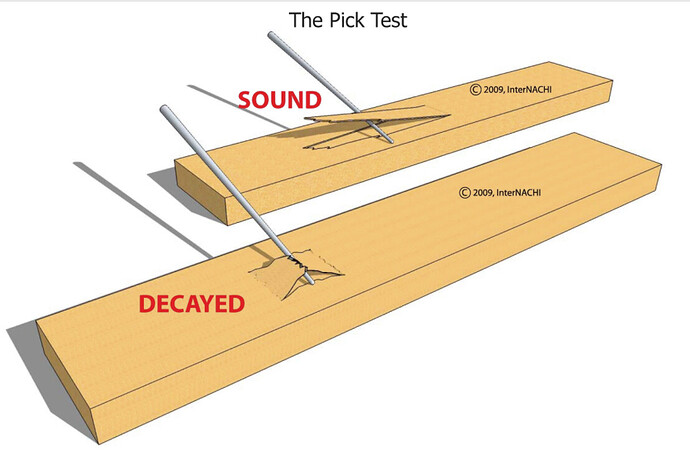I’ll be honest, sometimes for me it is not completely obvious with pressure treated pine. I will dig out a little soil and do this.
This is another area where Nachi SOP and Indiana SOP differ. Indiana addresses this specifically:
“d) Structural systems requirements are as follows:
(1) Licensees shall: (A) inspect:
(i) the structural components including foundation and framing; and
(ii) by probing a representative number of structural components where deterioration is suspected or where clear indications of possible deterioration exist, but probing is not required when probing would damage any finished surface or where no deterioration is visible”
Indiana does not define “probing”, but the Oxford definition of “probing” is to “physically explore or examine (something) with the hands or an instrument.”
So, if I want to pick-test it or just knock on it with my knuckles, I am required to “probe” suspected deterioration unless damage to a finished surface would result.
To be fair, potentially. I don’t listen to the in flight safety talk because I expect it’s just like the other ones I’ve heard…
To be legalistic here. Depending on second or third hand advice from an Internet forum is suspect, especially a forum with so many strong opinions. In this case going to a primary source is easy:
California Business and Professions Code CHAPTER 9.3. Home Inspectors [7195 - 7199] keeps going, reading in part:
§ 7196.2. (a) If a home inspector observes any shade of yellow corrugated stainless steel tubing during a home inspection, the home inspector shall include that observation, and the following notification, in the home inspection report:
“Manufacturers of yellow corrugated stainless steel tubing believe that yellow corrugated stainless steel tubing is safer if properly bonded and grounded as required by the manufacturer’s installation instructions. Proper bonding and grounding of this product can only be determined by a licensed electrical contractor.”
And keep going deeper:
§ 7195. For purposes of this chapter, the following definitions apply:
(a) (1) “Home inspection” is a noninvasive, physical examination, performed for a fee in connection with a transfer, as defined in subdivision (e), of real property, of the mechanical, electrical, or plumbing systems or the structural and essential components of a residential dwelling of one to four units designed to identify material defects in those systems, structures, and components. “Home inspection” includes any consultation regarding the property that is represented to be a home inspection or any confusingly similar term.
Source: https://leginfo.legislature.ca.gov/
Note that if you’re a licensed contractor or SE, your duty as those things are primary. If you’re not, then the ‘reasonably prudent home inspector’ clause applies.
Note in particular
§ 7198 Contractual provisions that purport to waive the duty owed pursuant to Section 7196, or limit the liability of the home inspector to the cost of the home inspection report, are contrary to public policy and invalid… The time for commencement of a legal action for breach of duty arising from a home inspection report shall not exceed four years from the date of the inspection.
Which flies in the face of various “advice” dispensed on this forum at various times.
See also AB-1024 Home Inspector Licensure Act from 2020.
